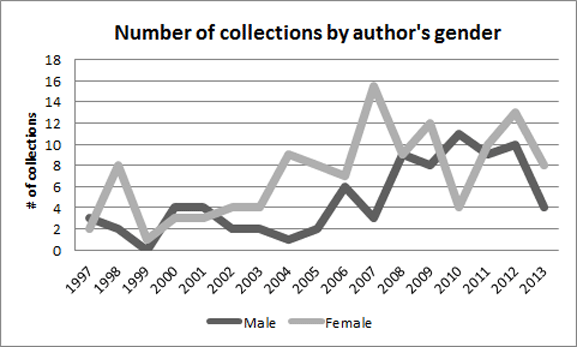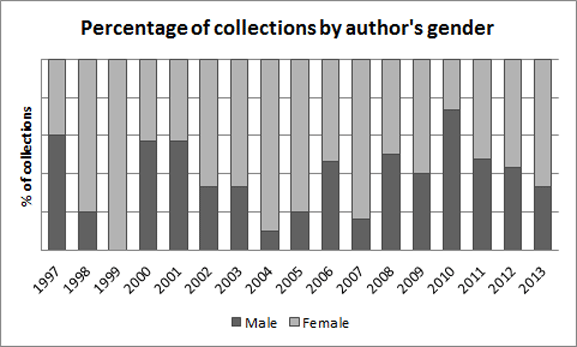Matthew Jarvis
Inspired by the work of Franco Moretti in Graphs, Maps, Trees: Abstract Models for Literary History (London: Verso, 2005), I present here a couple of graphs drawn from the bibliographic data collected so far by the Devolved Voices project.
First, a caveat: these graphs are concerned solely with the post-1997 cohort of Wales-associated poets. (For our definition of that cohort – which constitutes the project’s main focus, of course – please see the introduction to the ‘Collections’ bibliography.)
Within that context, then, what these graphs illustrate is gender division – numbers of collections/pamphlets by female authors, year on year since 1997, compared with numbers by male authors. The graphs go up to 2013 to include material that has been published so far in 2013 or that we know is scheduled to appear later in the year; however, the data for 2013 is inevitably incomplete at this point. Both graphs are based on the information in our ‘Collections’ bibliography as it stood on 1 July 2013.
This work was inspired by existing contentions which have stressed the particular importance of female poets to the post-1997 period. For example, writing in New Welsh Review in 2005, Kathryn Gray talked about a ‘vibrant re-awakening of Welsh poetry by younger women in recent years’ (‘Wales and the Next Generation’, New Welsh Review, 67 (2005), pp. 4-10: p. 8). Similarly, S. Rhian Reynolds’s 2009 discussion of ‘English-Language Poetry from Wales’ suggested that the ‘contemporary scene is dominated by women poets’ (in Ray Keenoy, S. Rhian Reynolds, and Sioned Puw Rowlands, The Babel Guide to Welsh Fiction (Oxford: Boulevard, 2009), p. 154).
Basically, I wanted to see if publication data broadly supported these sorts of ideas – and I hoped that graphic representations might be especially helpful in representing any trends.
Figure 1: post-1997 cohort of Wales-associated poets, number of collections by author’s gender

Figure 1, then, shows the number of collections/pamphlets published each year by Wales-associated poets in the post-1997 cohort, divided by gender. (I should note that I have not distinguished between collections and pamphlets in terms of the data used here: each individual publication counts, equally, as a single publication; if a single publication is the work of two poets, however, each author gets a 0.5 count for that particular publication.) This graph makes clear the growing publishing power of the cohort as a whole – presumably as new authors are added to the cohort year on year. Crucially, however, it also indicates that the growth of female-authored publications within our cohort significantly predates that of male-authored publications (indeed, male-authored publications are broadly level or moving downwards until after 2004).
Figure 2: post-1997 cohort of Wales-associated poets, percentage of collections by author’s gender

Figure 2, by contrast, presents the same data in terms of percentage distribution between male-authored and female-authored publications. Here, then, a post-2002 dominance of female-authored publications is striking, with only 2010 breaking from this pattern in any significant way. (In 2008, the distribution between male-authored and female-authored publications was equal.) In the years 2002-2009 – which is perhaps the period most obviously dominated by female authorship in the percentage terms shown here – nearly 69% of publications from our cohort were by women. Indeed, across the entirety of the years in my selection, the average is not much lower than it is during that apparent high-point, with slightly more than 62% of publications over 1997-2013 as a whole being by women.
Of course, data such as this cannot take into account the perceived influence of one poet as against another, or differences in profile. But these graphs do indicate that, in numerical terms at least, publications by female poets in our cohort have been strikingly dominant. The question of why this might be so – and how such data might compare, say, to the situations in England or Scotland – is clearly a topic for further investigation.
1-July-2013


